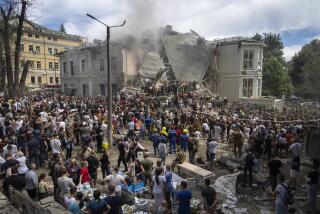NATO Hits Serb Missile Sites; Siege of Bihac Grows
- Share via
WASHINGTON — Allied warplanes launched another series of bombing raids against Serbian-held positions near the Bosnian Muslim enclave of Bihac on Wednesday, but Serbian nationalist ground forces intensified their siege of the U.N. “safe area,” raising fears that it may fall soon.
Warplanes of the North Atlantic Treaty Organization hit in three separate strikes, targeting two Serbian nationalist antiaircraft missile sites that had threatened allied fighter jets, as well as a Serbian air-defense battery that fired at British jets Tuesday.
The Clinton Administration continued to press U.S. allies to widen NATO’s military involvement in an effort to prevent the fall of Bihac but again met resistance from France and Britain, which are fearful that their peacekeeping troops in Bosnia-Herzegovina will come under fire.
Washington also is considering launching a major U.S.-led airdrop to deliver humanitarian relief supplies to the Bihac region. The area, which contains 170,000 people, has been denied support from U.N. aid convoys since last May.
The developments came as Bosnian Serb forces set up blockades at key points around the capital of Sarajevo, apparently in retaliation for NATO air strikes Monday, penning in U.N. peacekeeping forces stationed there.
The flurry of activity left the situation much as it has been for days--with a diplomatic stalemate in the face of increasing urgency on the military front--as the Serbs press on toward complete control of Bihac.
Analysts said that the outcome could be important because Bosnian government officials have hinted that if Bihac falls to the Serbian nationalists, the Muslim-Croatian confederation will pull out of the Western-led peace process.
Some policy-makers also fear that a Serbian takeover of Bihac might prompt Croatian President Franjo Tudjman to launch a new war in Croatia, which borders on the Bihac enclave and has a substantial Serbian nationalist population.
It was not immediately clear how quickly the United States and its European allies might be able to reach any consensus on what to do about the deteriorating situation in Bihac. NATO’s policy-setting North Atlantic Council met Wednesday but deferred action.
Foreign ministers of the United States, Russia and the European allies plan to gather Dec. 2 for a meeting of the so-called Contact Group, which oversees negotiations for a Bosnian peace pact, but the outlook for the session is uncertain.
U.S. officials have been pressing for NATO to declare the Bihac enclave a weapons-exclusion zone--a move that would bar Serbian tanks, artillery and other heavy weapons from the area and permit allied warplanes to attack them.
Washington also has suggested launching direct air strikes against the Serbian nationalist forces--both in Bosnia and in neighboring Croatia--that currently are attacking Bihac. And it wants to allow NATO warplanes to pursue Serbian aircraft into Croatia to shoot them down.
The Clinton Administration’s hope in pushing such proposals is to pose a big enough military threat to the nationalist Serbs to discourage them from completing their takeover of Bihac and possibly even push them into signing a peace accord with the Bosnian Muslims.
But European governments fear that intensifying the fight against the Serbs will only provoke them into retaliating by attacking U.N. peacekeeping troops, particularly the French, British and Dutch forces now stationed in the Sarajevo area.
Clinton has been under growing pressure from Congress to lift the arms embargo against the Muslim-led Bosnian government. The lawmakers contend that the Muslims would then be able to force the Serbs to come to some sort of terms.
Under a congressional compromise, the Administration last week announced that U.S. forces would no longer help to enforce the U.N. embargo, setting off a vigorous protest from European allies.
European officials argue that the Serbs would retaliate by attacking the U.N. peacekeeping troops if the arms embargo were lifted, obliging the United States to send American troops to help evacuate the U.N. forces, which it has promised to do in case of an emergency.
Wednesday’s air strikes were the second set of attacks by NATO warplanes against Serbian nationalist targets this week.
On Monday, Western warplanes launched a limited attack on a Serbian nationalist air base and on missile and antiaircraft artillery sites in south-central Croatia, destroying the air defenses and making the runways and taxiways unusable.
Wednesday’s air assault was carried out by more than two dozen American, British, French and Dutch planes against Serbian antiaircraft missile batteries at Otoka and Bosanska Krupa in northwestern Bosnia and Dvor in the Serbian-held Krajina area of Croatia.
One of the Serbian missile sites had fired at British Harrier jets Tuesday. Others had “illuminated” NATO planes with radar--an action that often signals that an antiaircraft missile is about to be fired.
Allied planes also fired several air-to-ground missiles to knock out other radar sites in the area.
Separately, Yasushi Akashi, who heads the U.N. Protection Force in the former Yugoslav federation, claimed to have negotiated a temporary cease-fire with Serbian nationalist leaders that would ease tensions in Bihac, but U.S. officials were skeptical. Analysts noted that previous deals have fallen through soon after Akashi announced them.
Times staff writer Carol J. Williams in Vienna contributed to this article.
NATO Strikes
NATO planes attacked three Serbian antiaircraft sites Wednesday, striking at one target twice to make sure it ceased threatening allied aircraft.
Source: Associated Press
More to Read
Sign up for Essential California
The most important California stories and recommendations in your inbox every morning.
You may occasionally receive promotional content from the Los Angeles Times.













